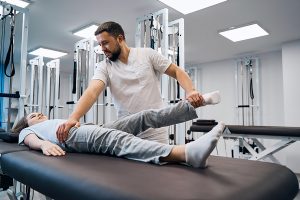Scoliosis is a very common spinal deformity in children. It’s estimated that more than four million people have scoliosis, and it leads to almost 29,000 surgeries each year in the U.S.
Children are not the only ones facing scoliosis. An estimated 229,000 adults are hospitalized every year for scoliosis care. Long-term care is often required. Even higher, around 2.7 million patients see a chiropractor each year for scoliosis or similar complaints. Almost one quarter of the people, both adults and children, with scoliosis report having excruciating pain.
Because scoliosis is so common and impacts so many children, it’s important to understand what the condition is, how it progresses, and why it’s so important to work with orthopedists to find the best path forward to ease pain and improve mobility and emotional outlook.
Understanding Scoliosis: What the Condition Is and How It Progresses
Scoliosis is a spinal deformity where a section of vertebrae curve or tilt, which creates a bowed section of spine. That curvature leads to discomfort and often a visible hunch in the back. It’s diagnosed initially during a medical screening using the Adam’s Forward Bending Test.
During this test, which is commonly performed in schools once a child turns 9 and until around the age of 13, the child bends over while the spine is measured for any sign of rotation.
Before you can even understand why a sports and orthopedics specialist is the best choice for scoliosis care, it’s important to understand what causes this spinal deformity. The thing is, there are many causes and types of scoliosis, but the most common one is idiopathic and has no clear cause or is tied to a genetic issue or multiple factors. The other types of scoliosis are:
- Accidents – Trauma to the spine occurs and causes the curvature.
- Adult Degenerative (De Novo) – Occurs during adulthood and is linked to the degeneration of spinal discs or trauma.
- Congenital – Spinal defect was present at birth.
- Infantile – Presents itself before the age of 3 and is tied to bones that do not grow properly.
- Juvenile – Presents itself between the ages of 3 to 10 when the spine is still actively developing.
- Neuromuscular – Accompanies other diseases, such as cerebral palsy.
Scoliosis is rated using the Cobb angle. This is a calculation of the angle of the curvature that’s measured using the two vertebrae that have the greatest tilting. It has its downfalls as it uses two-dimensional imaging to determine the angle. A spine isn’t two dimensional. Advancements in diagnostics make it possible to use 3-D scans to get more accurate curvature calculations.
There are also levels of scoliosis, including mild, moderate, and severe. The treatment options are often closely tied to these levels.
- Mild – Curvature of less than 20 degrees that requires a watch-and-wait approach while doing spine strengthening exercises.
- Moderate – Curvature of 20 to 40 degrees that requires a back brace to stabilize the spine.
- Severe – Curvature over 40 degrees that often results in a need for surgery.
Signs and Symptoms of Scoliosis
What signs indicate that scoliosis might be present? Often, the hips and shoulders are uneven, with one shoulder blade higher than the other. When a person stands straight, they may lean slightly to one side. The waistline may not appear even.
Common and some of the less common symptoms include:
- Back pain
- Balance and coordination issues
- Changes in bowel function
- Difficulty breathing
- Digestion changes and difficulties
- Fatigue
- Headaches
- Insomnia
- Muscle tension
- Neck pain
Orthopedic Management of Scoliosis
Ideally, you want to be diagnosed and start treating scoliosis as early as you can. If you can stop the progression of the spine’s curvature, you often avoid surgery and limit pain. For that reason, expect a treatment plan that includes the following.
For many individuals, especially those with milder curves or who are still growing, conservative management is the first line of treatment. The goal is to prevent curve progression and alleviate symptoms without surgery.
When you go to a doctor, expect to undergo the following tests and possible treatments.
- Measuring and Monitoring:
Observation of the spinal curves through imagining two or more times a year to measure progression. This is usually performed through X-rays.
- Wearing Back Braces:
If the curvature progresses, wearing a back brace may become necessary to support the spine and keep it from worsening. You’ll be measured for a perfect fit. That brace may be worn just at night (Charleston Bending Brace) or all day (Boston Brace). There’s also the less common Milwaukee Brace that’s more for high spinal curvature.
- Undergoing Physical Therapy:
Regular physical therapy sessions help strengthen core muscles, which improves posture and flexibility. That helps support the spine.
- Managing Pain:
When pain is a symptom of scoliosis, pain management is necessary. The first option is to use over-the-counter NSAIDs like ibuprofen. If it’s not enough, your orthopedist might recommend steroid injections or nerve blocks.
There’s also evidence that alternative therapies like massage therapy or ice or heat therapy can help. There are differing opinions on if heat or ice therapy is better. Some experts believe heat aids blood flow, which is better, but others feel constricting the blood vessels to ease inflammation is better. Our advice is to go with whatever helps you the most.
When Is Surgical Intervention Recommended?
Severe spinal curvature often leads to surgery for scoliosis. Typically, it’s advised once the curve of your spine exceeds 40 degrees. During a scoliosis surgery, vertebrae are fused to heal into a solid, straighter bone. Metal rods and screws help secure the position.
A bone graft from your own bone or donor bone is possible to help heal the bone faster. If it’s grafted from you, it’s usually taken from your hip. It means another surgical site, which may increase the pain you’re in during the recovery. Donor graft or artificial bone graft may be a better option.
If surgery is required, most patients are in the hospital for a few days. Children may need to attend classes from home for up to six weeks. Normal activities can be resumed within two to six months in most cases. Bending and lifting objects need to be limited for the first six weeks after surgery.
After the surgery, your pain may seem worse than in the past. It can take a few weeks or months before you experience a decrease in pain. Some patients say it took a year, but then the pain was much less than in the past.
The Long-Term: Living With Scoliosis
The medical aspect of scoliosis is just part of the long-term picture. For children and teens, scoliosis can be damaging to their body image and self-esteem. Supportive care that helps them with emotional support is just as important.
As part of this, it helps to find support groups and orthopedists who can help them find ways to participate on sports teams or join clubs that focus on more physical activities like hiking or horse riding.
Orthopedists can help a child or adult learn how to manage weight and strengthen muscles for the activities they want to continue doing. Scoliosis doesn’t have to stop you from riding a bike or playing baseball with your friends. You may just need to learn safer ways to play or join others in your favorite activities.
Whether you end up needing surgery or are wearing a brace to support your spine, routine care is essential. Your long-term spinal health requires you to see an orthopedic specialist regularly to monitor for any changes, manage new symptoms, and maintain a treatment path that keeps you active and comfortable.
Schedule an Appointment With Premium Sports and Orthopedics
In the long run, scoliosis can affect mobility if it’s not properly treated. That’s why it’s so important to work with a sports and orthopedic doctor specializing in a comprehensive approach to scoliosis. You want lasting results. Premium Sports and Orthopedics has the expertise and supportive team you need to help you manage scoliosis for a lifetime.







